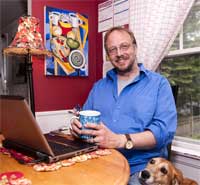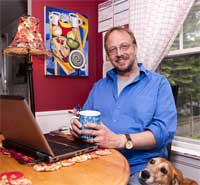 KINGSTON, RI – May 30, 2013 – You’re packing for a long trip to Mars and suddenly the anxiety hits: What to wear? You could suit up in bulky white duds or consider the advice of a University of Rhode Island professor: washable, recyclable clothes.
KINGSTON, RI – May 30, 2013 – You’re packing for a long trip to Mars and suddenly the anxiety hits: What to wear? You could suit up in bulky white duds or consider the advice of a University of Rhode Island professor: washable, recyclable clothes.
Karl Aspelund, an assistant professor of design at URI, says we should start thinking about what kinds of clothes astronauts will need for decades-long space missions, considered the next phase of exploration to infinity and beyond.
Questions that keep Aspelund up at night: How will astronauts do laundry in space? How can we recycle old clothes in space? Is there a way to make clothes in space?
Those questions might be answered soon. Aspelund just won a $15,000 grant from URI’s Council for Research to begin background research for the project, with the hope of eventually creating guidelines and prototypes.
Aspelund got interested in space apparel last year when he was sitting in his car in the driveway of his Warwick house listening to a National Public Radio report about the 100 Year Starship Initiative, a program aimed at inspiring travel beyond our solar system by 2112.
“It occurred to me as a designer and an anthropologist who focuses on clothing practices that I might be able to contribute to this,” says Aspelund. “I sent an e-mail asking whether anyone had looked into apparel needs for a mission of this length.”
The answer: no. Aspelund’s reaction: T-shirts in space!
An invitation followed from Mae Jemison, a former astronaut and leader of the Starship project, to attend a conference in Houston, where Aspelund intrigued engineers, astrophysicists and space-travel enthusiasts with his ideas.
“I was sort of the odd man out there at first,” he says. “There were astrophysicists, biologists and system engineers, and then there’s me with the dirty socks and laundry.”
This past March, he also talked about space attire at a science conference at the EU Parliament in Brussels and will speak again this fall at another Starship conference, again in Houston. The URI grant, awarded last month, allows him to rocket to the next level.
Working with three graduate students, he’ll collect information about space clothing worn by Russian and American astronauts and explore creating outfits with 3d printing, among other things. He also plans to research the ecological implications of the need to recycle space clothes, and he’ll interview former astronauts from the International Space Station, scientists on Antarctic bases and submariners about wearing clothes in isolated and sometimes harsh conditions.
If all goes as planned, he hopes to have prototypes for a space simulation in 2014 and, in coming years, for the International Space Station, where someone would actually wear the clothing for weeks or months to test hygiene, durability and recycling possibilities.
“I’m very excited to look into the current research on anti-microbials and recyclable fabrics, as well as the behavioral and cultural issues concerning clothing,” he says. “Prototyping will not only be very cool, but also absolutely necessary. You can only theorize so much when it comes to something as integral to human behavior and identity as clothing. The actual experience of wearing it, the feel and comfort – or lack thereof – happens over time. This will be just as important to figure out as the technical aspects of hygiene and recycling, especially when considering very long-term missions.”
Currently, astronauts at the International Space Station wear polo shirts and cargo pants, with lots of pockets. Dirty clothes and trash are put into a “supply craft” that burns up on re-entry into the Earth’s atmosphere.
That works efficiently, because so few people are involved and the time in space is relatively short. But long space trips are expected to have hundreds of people and last decades, possibly a lifetime. Aspelund says it’s unwise to assume that clothing on these missions can be tossed out in the same way. There’s simply too much dirty laundry and no opportunity for resupply.
Space explorers also need to think about ways to clean, recycle and repair clothes in space, Aspelund says. Material is important too. Maybe there’s an alternative to cotton and polyester; some scientists are already experimenting with sprays that cover the body. “We may need to retire the whole idea of clothing as we know it,” Aspelund says.
Earthlings can also benefit from Aspelund’s research. Lessons about reducing the ecological footprint in space can be applied to developed and underdeveloped countries. “It’s not all just about space,” he says. “Bringing the research back to Earth is the real kicker.”
What he finds can be key to continuing survival on this planet. “If we can create a closed-loop ecosystem in space that is self-sufficient in its use of materials, water and energy, we can transfer the solutions to Earth. Solving the problem within the severe constraints of a community on Mars allows the creation of sustainable communities on our home planet. Solutions will be applicable in Cambridge or Kalahari. To me, that’s no less exciting than the idea of contributing to a mission to one of Jupiter’s moons.”
Finally, his research should nudge space explorers into thinking about what kind of community they want to create on these long missions. Sure, you need someone who can drive the ship, but what about having creative souls, like writers and poets, on board? More important, what will they wear?
Clothes and fabric have fascinated Aspelund since childhood. Raised in Iceland, he remembers watching his grandparents at a cutting table turn cloth into garments. His grandfather, Thorhallur, was a tailor; his grandmother, Gudrun, was a seamstress.
“Working with fabric is in my blood,” he says. “It was a very natural progression to design and create.”
He received a bachelor’s degree in theater design at the Wimbledon College of Art in London in 1986 and eventually moved to the United States. He worked for eight years as a designer in the studio of the Providence-based artist Brower Hatcher, a nationally acclaimed sculptor.
In 1996, Aspelund started teaching in the Textiles, Fashion Merchandising and Design department. He earned his doctorate in anthropology and material culture in 2011 from Boston University. His dissertation, an examination of women’s national dress in Iceland, won the Boston University Professor’s Edmonds Prize for best dissertation in 2010-11. He is also the author of two books, “Fashioning Society” and “The Design Process.” A third book, an introduction to design, will be published within a year.
For the record, he speaks Icelandic.
Photo above: Karl Aspelund, an assistant professor of design at the University of Rhode Island who is researching how to design, make and maintain clothing in space.
Photo courtesy of Michael Salerno Photography.

